
Netball Scoop – Suncorp Super Netball – Round 12, 2021
Contributors: Andrew Kennedy, Emily Klaffer, Georgia Doyle, Ian Harkin, Cara Gledhill, Jenny Sinclair, Katrina Nissen
Photographers: Marcela Massey, Simon Leonard, Nick Bleeker (The Goal Circle podcast)
RESULTS
West Coast Fever 64 def. Melbourne Vixens 50 (17-15, 21-9, 14-15, 12-11)
Collingwood Magpies 75 def. New South Wales Swifts 68 (19-13, 18-17, 21-17, 17-21)
West Coast Fever 79 def. Queensland Firebirds 69 (20-15, 21-20, 17-18, 21-16)
GIANTS Netball 54 def. Melbourne Vixens 45 (14-12,13-8, 16-12, 11-13)
Adelaide Thunderbirds 61 def. Sunshine Coast Lightning 60 (18-14, 10-17, 18-12, 15-17)
INJURIES
Kiera Austin (GIANTS) – ACL (season)
Liz Watson (Vixens) – foot (season)
Ash Unie (Lightning) – ACL (season)
Tara Hinchliffe (Firebirds) – ACL (season)
Tippah Dwan (Firebirds) was forced out of the Round 12 game as she continues to serve out quarantine after being at a Tier 1 exposure site. She was replaced in the side by Mia Stower.
Shadine van der Merwe (Thunderbirds) was rested due to a lower leg injury.
In another tough blow for the Firebirds, wing attack Jemma Mi Mi left the court in the fourth quarter with a suspected Achilles injury. Mi Mi will have scans this week, but the injury didn’t look good.
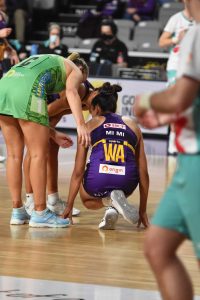
Jemma Mi Mi went down with a suspected Achilles tendon injury.Image Marcela Massey
MILESTONES
Our congratulations to:
Malawi Queens superstar Mwai Kumwenda (Vixens) who played her 100th national league game on Thursday. She was first signed to the Mainland Tactix in the ANZ Championship in 2014 and has grown her game to another level since being signed to the Vixens. She was named MVP in last year’s grand final victory.
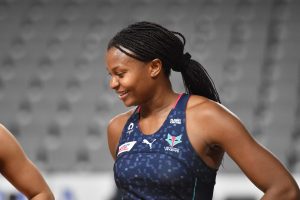
Mwai Kumwenda played her 100th national league game for the Vixens. Image Marcela Massey
Kaylia Stanton of the Melbourne Vixens for playing her 50th national league game. Stanton played the majority of these games for the West Coast Fever, but has come over from WA this year to continue her SSN career.
Stacey Marinkovich who notched up her 100 games as Fever coach, coincidentally in Brisbane where she also coached her first game.
Umpire Kate Wright, who officiated her 50th national league match in the Giants v Vixens match. Kate has also umpired at an international level for more than 15 years.
Bec Bulley, for her first match as a head coach. Bulley has temporarily stepped into the role with Briony Akle locked down in Adelaide.
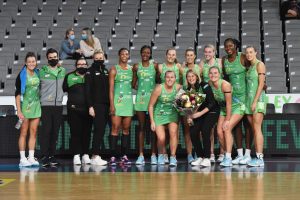
Stacey Marinkovich coached her 100th national league match. Image Marcela Massey
ROOKIE OF THE ROUND
Elle McDonald (Thunderbirds) was the steadying influence that the Adelaide Thunderbirds needed to help them upset the Lightning. With Hannah Petty’s errors creeping up, McDonald entered the court at centre in the second quarter. She proved to be a cool head under pressure, making just three errors as she added 12 feeds and one gain to her tally. What the stats don’t show is her linking play between the defensive and attacking ends of the court – she was always available for the pass, setting up Georgie Horjus and Maisie Nankivell to feed the circle. It was a composed performance for a young player entering a high stakes game on the back of limited court time.
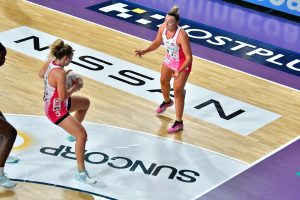
Elle McDonald was our rookie of the round after a steady, consistent performance. Image Simon Leonard
PLAYS OF THE ROUND
Vixens head coach, Simone McKinnis, isn’t afraid to have the tough conversations that rugby stalwart Ricky Stuart seems to think netball can’t have. Her press conference after the GIANTS match was raw, open and honest, and well worth a listen.
With no SSN matches over the weekend, and many states in lockdown, fans were looking for ways to amuse themselves. Enter a netty trivia afternoon, the brainchild of ConciergeMaree. With 34 people scratching their heads over esoteria such as “How long is the Colin Jenkins ad?” and “On average, how many times does Maddy Proud hit the deck per match?” @DohertyFayth ran out the winner with 41//50 correct. Thanks to Emma for her work on what sounds like a fun afternoon.
With Swifts’ coach Briony Akle locked down in Adelaide with two of her children, after possibly being exposed to a Covid site, assistant Bec Bulley took over the reins. It was a baptism of fire, with the Swifts being overpowered by the Magpies, but Bulley took it all in her stride.
TEAM OF THE ROUND
Both the Magpies and the Thunderbirds deserve applause for their victories over the Swifts and Lightning respectively. The results have significantly impacted the ladder, with Fever leapfrogging them both from fourth into second. As a result, there is still a statistical chance that if the Fever, Swifts or Lightning lose both matches they could drop out of the top four, while either the Firebirds and Magpies could make it in if they also win both matches.
The Magpies took control of their match in the first quarter, and apart from a brief lapse at the end of the first quarter, never looked like being headed. There were contributors all over the court, but the most pleasing aspect of the win was how well the various units worked together. The defence picked off 17 gains, the midcourt found a strong route to goal with just 20 turnovers, and Shimona Nelson shot an incredible 69/71.
The Thunderbirds win was completely different, with the lead changing on a number of occasions. Often guilty of throwing away ball, the Thunderbirds maintained their composure and hung on for a narrow one goal win.
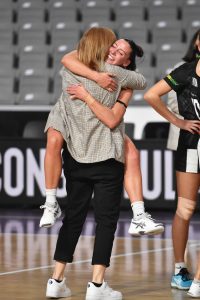
After losing her grandmother over the weekend, a win put a smile on Kelsey Browne’s face. She’s being embraced by coach Nic Richardson here. Image Marcela Massey
STATISTICALLY SPEAKING
Tough ask for Jhaniele Fowler to get any better, but with 64/66 against Firebirds the Jamaican legend beat her previous season best record of 62, against the same opponent in round seven. The Firebirds goalkeepers have managed only one single gain this year in 120 minutes of netball against the West Coast Fever. Fowler’s average score for the year is now 55.8 points in a match.
It was a significant round for shooters, with Fowler scoring 58/58 in Fever’s other match, Shimona Nelson reaching 69/71, and Lenize Potgeiter 40/41.
There were also two interesting “goals from gains” across the round. The Firebirds managed to nail 100% of their gains (6/6) which hasn’t been managed this season to date. At the opposite end of the spectrum, the Swifts will rue the opportunities that got away, converting just 2 of their 12 gains, at the disappointing rate of just 17%.
Gains, gains, and how to flatten that curve? Round twelve saw the lowest gains for Fever this year, only eight, begging the question, how many is good, and how low can you go? Firebirds also came off badly, equally their year-low of six gains. The best this year goes to Thunderbirds with 25 when they played the Magpies in round eleven in Adelaide. They also take equal second spot, thanks to Shamera Sterling, with 24 in round nine, the same as Lightning in round six facing Giants.
The lowest gains of the year for a match was round one – Swifts had a regrettable four, the worst for the year of all teams, and Firebirds seven, totalling eleven in a game. The next lowest was Firebirds/Lightning in round eleven, six each, and Fever/Lightning in round three with thirteen all up.
And while it’s common for teams to be close on gains, it is again Adelaide who get the biggest wins on that stat – round seven 21-7 gains when they beat Swifts, then bested by themselves in round nine when they dominated Collingwood, 24 gains to 8.
TALKING POINT OF THE ROUND
With South Australia going into lockdown, all eyes were on Netball Australia to see what would unfold. Cue a “hubble” in Queensland, which while it has the advantage of keeping the season alive, means that a number of the teams will have to quarantine for two weeks on return to their home states.
It must have been a challenge putting the draw for the final three condensed rounds together, with some interesting intervals between games. A couple of teams have had a 9 day break, while the Firebirds and Magpies will face off in a must win attempt, just two days after their previous match.
Despite this, the athletes are delighted to resume and – fingers crossed – finish the season.
TWEET OF THE WEEK
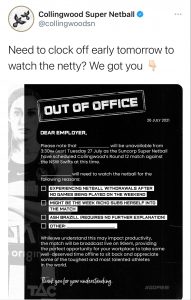
Thanks for the assist with the boss, Magpies
STAND OUT STATISTICS
INDIVIDUAL
Shooting Volume
Shimona Nelson (Magpies) – 69/71 (97.2%)
Jhaniele Fowler (Fever) – 64/66 (97%)
Supershots
Mwai Kumwenda (Vixens) – 5
Alice Teague Neeld (Fever, Round 8 rematch) – 5
Sam Wallace (Swifts) – 5
Goal Assists
Gabrielle Sinclair (Magpies) – 35
Maisie Nankivell (Thunderbirds) – 35
Gains
Sarah Klau (Swifts) – 7 (5 intercepts, 1 deflection with gain, 1 rebound)
Emily Mannix (Vixens) – 7 (1 intercept, 1 deflection with gain, 5 rebounds)
Deflections
April Brandley (GIANTS) – 8
Geva Mentor (Magpies) – 8
Centre Pass Receives
Gretel Bueta (Firebirds) – 32
Kelsey Browne (Magpies) – 31
Penalties
Rudi Ellis (Firebirds) – 22
Ward (Magpies), Jenner (Firebirds), Mannix (Vixens) and Garrett (Thunderbirds) – 19
Turnovers
Maddy Proud (Swifts) – 9
Kaylia Stanton (Vixens) – 9
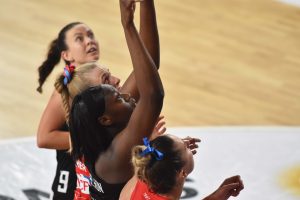
All eyes on the ball – the Swifts defenders watched 69 of Shimona Nelson’s goals land. Image Marcela Massey
TEAM
Shooting Accuracy
Thunderbirds – 60/62 (96.8%)
Magpies – 74/77 (96.1%)
Gains
GIANTS Netball – 18
Magpies – 17
Vixens – 17
Supershots
Swifts – 9
Vixens (R8 and R12) – 5
Turnovers
Vixens – 27
Thunderbirds – 24
Penalties
Firebirds – 68
Vixens – 66
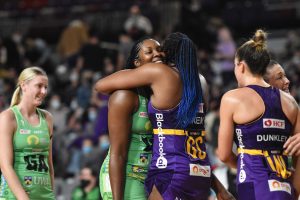
A hug between Jamaican teammates after the match. Image Marcela Massey
MATCH REPORTS
WEST COAST FEVER 64 def MELBOURNE VIXENS 50 (Rescheduled Round 8 game)
By Cara Gledhill
WHO dominated?
The Fever ran a smothering through court defence throughout the game with all players on court contributing. Sunday Aryang continued to make a strong case for Australian selection and was outstanding in covering the leads of Vixens goal attack Kaylia Stanton and forcing her into turnovers. Her impact on Stanton was more impressive for the lack of penalties Aryang gave away with just five for the game. This pressure in front was crucial in allowing Courtney Bruce to come through with her trademark intercepts.
Jhaniele Fowler continues to put out consistently impressive performances and this game was no exception. While there were a couple of patches in the game where Emily Mannix had some significant wins on Fowler, she was able to adjust her body positioning and limit Mannix’s impact in the remainder of the game.
Jess Anstiss also had a strong game at centre, acting as a crucial link in transition in a dominant performance from the Fever midcourt. The battle between her and Kate Moloney, who was the best on court for the Vixens, was one to behold. Both players were quick onto loose ball and the physicality between them was intense from the first whistle.
WHAT worked?
The Fever executed a stifling full court defence, cutting off the Vixens usual attacking structures. On the centre pass, Stacey Francis-Bayman, Jess Anstiss and Sunday Aryang were effective in creating a wall and preventing the easy pass off to Stanton and Mundy which had been effective in previous rounds
The Fever’s defence was also set up around keeping the feeders, particularly Kate Moloney and Hannah Mundy, from their preferred circle edge feeding position. With hands over pressure from the Fever on every pass blocking all paths into the circle, the Vixens lost their easy passing options and were forced into long cross-court passes.
The Vixens significantly lifted in the second half of the game and were able to challenge the would be table toppers by shortening their passes and changing up their approach to the goal circle. The second half was even with both teams scoring 26 goals after halftime. This is impressive for a young Vixens team who, with finals no longer a possibility, will be looking to cause some upsets in the last few games of the season.
WHAT needs improvement?
The effect of the Fever defensive pressure all across the court was that it made the Vixens players work all that much harder, resulting in unforced errors all over the court.
The constant work in covering leads which was done by Jess Anstiss, Francis-Bayman and Aryang also forced the Vixens midcourt to run back and forth in an attempt to lose their players, inevitably resulting in tired legs by the end of the game. Hearing Simone McKinnis yell “pass and cut” repeatedly on the sideline told you part of what was going wrong for the Vixens who lacked drive particularly in the first half of the game.
The Fever will be disappointed that they couldn’t press their advantage over the Vixens. After a very strong start, they let the Vixens back in. They were then unable to increase their 14 goal margin they took into halftime, with the Vixens taking the third quarter by a single goal. Crucially, heading into finals the Fever will need to lift their third quarter efforts. They turned over the ball eight times during that stanza after only having six general play turnovers at halftime.
WHERE was it won? (At what point was the game won and why)
While it was technically still possible for the Vixens to bridge the gap after halftime, it was unrealistic for them to come back from so far down without any kind of response from the Fever. The Vixens’ slow start to the game meant they never looked like bridging the gap. The Fever were simply too consistent in their full court performance.
HOW did she do that?!
Halfway through the first quarter, Fowler took a sensational ball in the air, barely balancing it with one hand and then the other while managing to stay inside the line. There were many such moments throughout the match, but Fowler’s early dominance was a joy to watch. .
MVP: Alice Teague-Neeld (Fever)
Starting lineups:
Fever: GS Fowler, GA Teague-Neeld, WA Charles, C Anstiss, WD Francis-Bayman, GD Aryang, GK Bruce
Vixens: GS Kumwenda, GA Stanton, WA Mundy, C Moloney, WD Eddy, GD Weston, GK Mannix

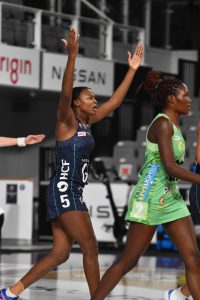
Mwai Kumwenda revving her team. Image Marcela Massey

Olivia Lewis has one of the best vertical jumps in the league. Image Marcela Massey
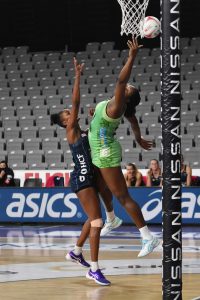
Jhaniele Fowler turns herself inside out to take this ball against the Vixens’ Kadie-Ann Dehaney. Image Marcela Massey
COLLINGWOOD MAGPIES 75 def NEW SOUTH WALES SWIFTS 68
by Georgia Doyle
WHO dominated?
Shimona Nelson played arguably the best game of her career, scoring her highest total with 69/71 shots and picking up the rebounds from her two missed shots. Nelson was quick to credit those around her during her post-match MVP interview, and while the feeders were able to provide her with good ball, it was her ability to position against Swifts and Diamonds GK Sarah Klau that allowed the feeders to place the ball exactly where it needed to be.
In previous years, Nelson has been criticised for her soft hands and high turnover rate – this week she only committed three turnovers, of which only one was put down to ‘bad hands’. The work Nelson has put into this aspect of her game is phenomenal. She has also become stronger physically, not being pushed off the hold by defenders as she has in previous years.
An honourable mention must also go to Sophie Garbin, who came in to GS for Swifts at the start of the second quarter and made a strong impact, yet again showing her strength and confidence when playing at her preferred position of GS. Swifts scored only 13 points in the first quarter with Sam Wallace at GS, but managed 17, 17 and 21 in the remaining three quarters with Garbin on court, contributing 33/35 during her 39 minutes on court. She also kept opposition Geva Mentor quiet, she had three gains in the first quarter, but only managed two for the remainder of the game
WHAT worked?
The attacking end for Magpies was absolutely humming for the entire 60 minutes. Spearheaded by MVP Nelson at GS, all three feeders were able to find good feeding position, both on and off circle edge. Gabby Sinclair accrued a massive 36 feeds, of which 35 lead to an attempt at goal. Kelsey Browne at WA and Molly Jovic at C also had 28 and 22 feeds respectively, with Swifts defensive mid-courters unable to find the combination to combat the speedy attackers of Collingwood. All attackers were able to find space away from their defenders, and execute a quick release into Nelson. With defenders like Klau and Maddy Turner, a quick pass into the circle is vital in limiting their time to read the ball and set up to contest.
WHAT needs improvement?
The lack of a Swifts specialist WD is yet again proving problematic, especially against the stronger WAs in the league. While Lauren Moore can apply strong hands over pressure due to her height advantage, which over Browne was 20cm, she was often caught in chase mode against the speed of Browne, especially when she cuts and drives on and off the circle edge to gain better feeding position.
The switch of Tayla Fraser into WD during the second quarter meant a better match for speed, but this is still an unfamiliar position for Fraser and against a world class WA it unfortunately showed. While there are still a few weeks until the end of the season and the new contracting period, Swifts will have to start thinking about their 2022 roster and whether they continue to invest in moulding a WD from their existing squad or if they look at trying to bring a new player into the squad.
WHERE was it won?
Magpies defenders had one of their best combined games for the season, with Jodi-Ann Ward and Geva Mentor combining for a total of 11 gains, while Ash Brazill also notched up three from WD while shutting down every WA that she had thrown at her. Swifts are usually clinical in attack, but they seemed unable to find their connections this week, while this did improve with Garbin on court it unfortunately wasn’t enough to secure a win.
Collingwood have a defensive unit capable of striking fear into any attacking line-up, but haven’t all been able to fire simultaneously this season. Unfortunately for Swifts, the week Magpies clicked was against them. They were able to confuse the space in the shooting circle, keep feeders of circle edge and peel off for intercepts through the mid court.
WHERE was it lost?
Two of the key statistics often looked at by high-performance staff, but not so much the fans, is percentage of goals scored both from centre pass and from gains. In no surprise, Magpies dominated in both of these areas throughout the game. Collingwood scored off 82% of their centre passes, which is a number most coaches would be very impressed with. Swifts also managed a respectable 75% scoring off centre pass, but it was scoring from turnovers where Swifts really struggled.
They only scored off 2/12 gains, which resulted in 17% compared to Magpies 59%. Also, both of these conversions occurred in the final quarter by which point the defenders were exhausted and looked visibly defeated after slogging away all game just to see their efforts thrown away through court. With Swifts facing Lightning and Thunderbirds, both of whom they haven’t beaten this year, they’ll need to improve this area to stay in the top two and keep their chance at a double shot during finals.
HOW did she do that?!
It’s not very often that you see a two pass play to goal, let alone when a WD takes the centre pass. But when Ash Brazill is on court, always expect the unexpected. She took the centre pass, level with the centre circle, wound up the arm, spotted that Klau was out hunting and hurled the ball into Nelson under the post who, in keeping with her excellent form throughout the match, nailed the shot.
MVP: Shimona Nelson (Magpies)
Starting lineups:
Magpies: GS Nelson, GA Sinclair, WA Browne, C Jovic, WD Brazill, GD Ward, GK Mentor
Swifts: GS Wallace, GA Housby, WA Hadley, C Proud, WD Moore, GD Turner, GK Klau
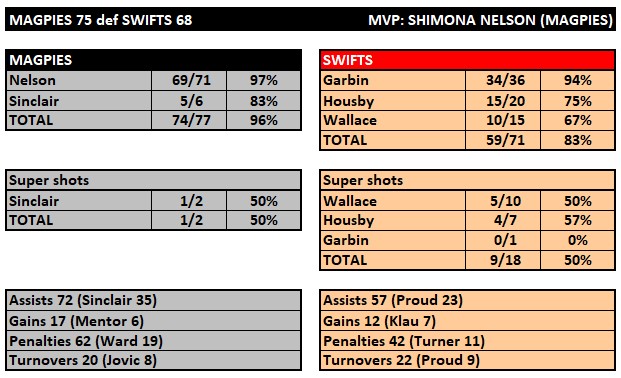
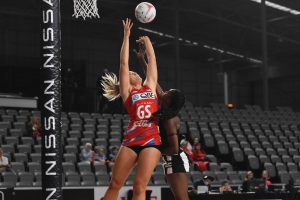
Incredibly strong on the hold and under the post, Sophie Garbin finished with 34/36. Image Marcela Massey
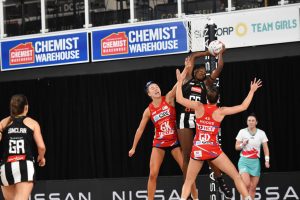
Shimona Nelson was an incredibly strong presence under the post, and the Swifts had few answers to her dominance. Image Marcela Massey
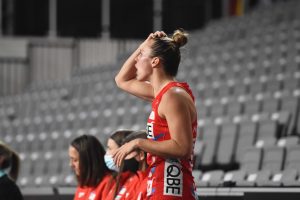
Paige Hadley had a rare stint on the sidelines as the Swifts searched for answers to the Mapgies. Image Marcela Massey
WEST COAST FEVER 79 def QUEENSLAND FIREBIRDS 69
By Andrew Kennedy
The last three rounds weren’t only a forum to analyse the top four sniping each other, they also would see each of the teams ranked fourth, fifth, and sixth playing off. In round 13 it would be Firebirds and Magpies, in the last round West Coast and Collingwood, and this week the Queensland Firebirds against West Coast Fever.
With fourth-ranked Fever looking good for a run at the premiership, after two recent grand final appearances, it would be all up to Firebirds to stoke their own dreams of another title and dominate this round 12 fixture. Sadly it was marred by a potentially season-ending injury to a key midcourt player in the third quarter, Jemma Mi Mi helped off with a suspected Achilles injury after only four minutes of play.
With a scoreline precisely the same as in round seven, Fever didn’t let Firebirds have a run-on at any time. They showed their maturity, perseverance, control, and spark, to almost extinguish the Queenslander’s finals hopes, winning 79-69.
WHO dominated?
The Charles-Fowler show was in full swing, with a touch more composure on the feed since the Fever lost matches in rounds eight and nine. Jhaniele Fowler decimated the Firebirds with her highest total of the year, 64 goals – the second highest of 62 was also against Firebirds in round seven. This year, the Queensland team goal keepers have had only one gain in two matches against West Coast, who continued with too much variety, timing, accuracy, and options.
Verity Charles was in peak performance. Outplaying one of the world’s best wing defenders, Gabi Simpson, she showed not just athleticism but precision, balance, timing, and leadership, with 26 goal assists and only 2 turnovers. Her evolution this year has been firstly to not always run on and pass, instead to choose when to hold her feet, but also to know when a change of angle will confuse the defence better, giving faith to her partner in midcourt, passing to the tough and reliable Jess Anstiss. Charles also was the only Fever player other than the circle defence to achieve gains, with two on the scorecard, while Simpson had zero gains in sixty minutes.
For Firebirds, they had good individual plays and some connections working at times, but not across the whole game. Gretel Bueta tidied up her usually high turnover stat, and shot 96% of 1-point attempts. She didn’t have quite as many goal assists, instead having more shots using her height advantage over Sunday Aryang to step in towards the post. Kim Ravaillion kept up her consistent and safe play this season, leading with 24 goal assists, and only 4 turnovers.
WHAT worked?
Fever have focused on their attacking timing after dropping two matches. It’s fascinating to watch a team of good defenders like Firebirds quite unable to cut off obvious leads – the Western Australians simply knew how to clear space and who was supposed to make the next lead. The result was that a second offer was hardly needed when Fever transitioned from defence to attack, as each of Teague-Neeld, Charles, and Anstiss knew precisely when to offer to the front space.
Firebirds at times used successful defensive strategies. In the first half, rookie Rudi Ellis used great timing off the mark and off the body, and her long reach to get little deflections and scares of the feed, forcing dropped balls by Fowler.
For both teams there was a slick attacking start with no turnovers for more than five minutes and goal-for-goal struggle featuring the Jamaican stars. Even at the end of the match the turnover stat was solid, 21 for Firebirds, and an excellent 16 for Fever. There was short, sharp passing and calmness from both in the lead up to the circle when required.
WHAT needs improvement?
Firebirds were reasonably low on errors, but the types of errors they gave were weighty. Many of them were focused on Aiken, either a feed that should never have been attempted, or trying to be unnecessarily cute and flashy. When the goal shooter was covered by Courtney Bruce, there was always a reset or triangle option, but unfortunately the Queenslanders didn’t always make the right decision to hold their feet and play safe.
Both teams found it hard to get defensive stops. It was Fever’s lowest gains for the year with eight, having previously had only nine in round three versus Lightning. Firebirds only had six, which equalled their lowest, in round eleven also playing Lightning. They also failed to force extra turnovers across the court, so the heat will be on the coaches and statisticians to analyse the weakness to exploit in weeks ahead.
WHERE was it won?
Fever always had the upper hand in a tough contest. The key was their unrelenting defence which built pressure and rarely gave away penalties. While Firebirds weren’t too bad with 67 all told, Fever only had 37, so they used footwork rather than the body and raised arms to frustrate Firebirds.
WHERE was it lost?
There weren’t many decisive runs of play in the match, with both teams only able to string together 3-4 goals in a row and momentarily threaten a change of momentum. After the first quarter 20-15 win to Fever, Firebirds couldn’t get closer than 2. This belies an issue for both teams. Firebirds can build but then choke with a rushed feed over the baseline, whereas Fever get some confidence but don’t put the pedal down and totally dominate and demoralise the opponent. This kind of strength comes from a zen clarity in attack and a ruthless mindset in defence, the type that is necessary to make the top four and win finals.
MVP: Verity Charles (Fever)
Starting lineups:
Fever: GS Fowler, GA Teague-Neeld, WA Charles, C Anstiss, WD Francis-Bayman, GD Aryang, GK Bruce
Firebirds: GS Aiken, GA Bueta, WA Dunkley, C Ravaillion, WD Simpson, GD Jenner, GK Ellis
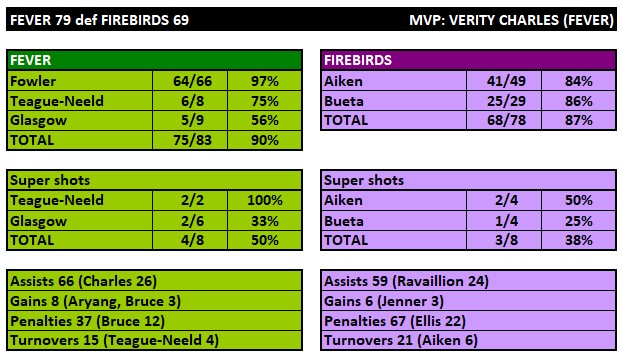
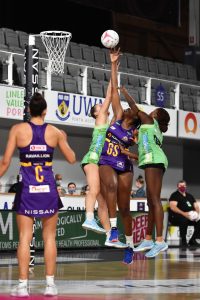
Fever managed to keep their penalties well under control, giving up just 11 until half time. Image Marcela Massey

Firebirds making life difficult for Fever at the centre pass. Despite this, Fever converted from 83% of their centre passes. Image Marcela Massey
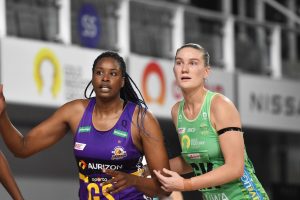
While Courtney Bruce only came away with 3 gains – less than usual – she kept Romelda Aiken to 41/49 goals. Image Marcela Massey
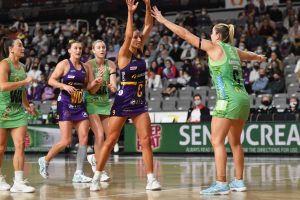
The match up between Kim Ravaillion and Jess Anstiss was intriguing. Both centres have been in fine form this season. Image Marcela Massey
GIANTS NETBALL 54 def MELBOURNE VIXENS 45
By Emily Klaffer
WHO dominated?
Wing defences often don’t get the praise they deserve, but Amy Parmenter showed her defensive prowess on the in form Hannah Mundy of the Vixens. She toughed it out and worked with Jamie Lee Price to disrupt the Vixens attack line.
Price led the match in Nissan Net Points and gave a fine centre performance both in the attack and defensive end. She finished with two intercepts, two deflections and just one turnover.
WHAT worked?
The GIANTS remained calm when the defensive press of the Vixens came in patches. Captain and goal shooter Jo Harten remained strong literally and figuratively and led her young attacking line to an impressive first half.
Harten and goal attack Sophie Dwyer shared the shooting role both in regular time and in the super shot period which split the defensive duo of Jo Weston and the interchanging goal keeper position held by Kadie-Anne Dehaney and Emily Mannix.
WHAT needs improvement?
The Vixens shooting woes weren’t helped by a low scoring accuracy and poor volume in goals. The Vixens attackers looked stunted at times and experienced and decorated shooter Mwai Kumwenda ended the match with an unusual 29/34. Kalia Stanton also struggled to hit the middle of the ring with 4/9 in regular time and 0/2 super shots.
If the reigning premiers want to finish this season with some pride and momentum into next season, they’re going to have to work on their shooting.
WHERE was it won?
The GIANTS cleared a win on the board with a strong first half, they kept the Vixens to an eight goal quarter in the second term and were able to push forward with a further four goal lead increase. The Vixens won the last quarter but the GIANTS early surge cemented their solid win.
WHERE was it lost?
Despite losing Caitlin Bassett and Keira Austin at the start of the season, the GIANTS have built strong combinations all over the court. With the disruption to the Vixens line-up, the combinations, particularly in the shooting circle, are yet to gel. The Vixens couldn’t find a proper route to the ball and the GIANTS defence snapped any loose ball up.
HOW did she do that?
The best players are the ones with the loudest on court voice, the entire city of Brisbane could hear when Kumwenda screamed for the ball for a classic home alone moment. Arguably the best piece of play for the Vixens for the match, Kumwenda will knock those goals down every time.
MVP: Jamie Lee Price
Starting lineups:
Giants: GS Harten, GA Dwyer, WA Hay, C Price, WD Parmenter, GD Brandley, GK Poolman
Vixens: GS Kumwenda, GA Stanton, WA Mundy, C Moloney, WD Eddy, GD Weston, GK Mannix
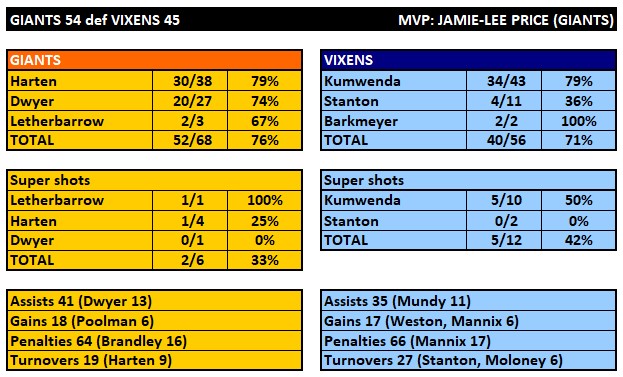
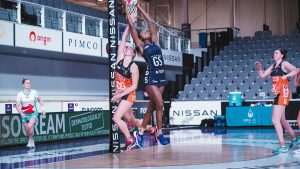
Mwai Kumwenda had some struggles at the post, hitting 34/43 under close attention from the GIANTS defenders. Image supplied by Nick Bleeker (The Goal Circle)
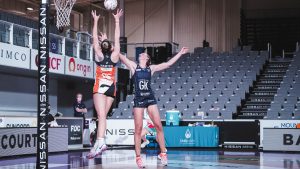
Jo Harten led by example at the front of the court for GIANTS. Image supplied by Nick Bleeker (The Goal Circle)
ADELAIDE THUNDERBIRDS 61 def SUNSHINE COAST LIGHTNING 60
By Ian Harkin
In a result that puts Lightning’s finals participation in jeopardy, the team from the Sunshine Coast went down in a thriller to the Adelaide Thunderbirds 61-60. It was a match of fluctuating fortunes as first one team was on top, then the other, but it was Thunderbirds who were in front when it mattered most. They reversed the outcome of the teams’ round five clash when Lightning prevailed by just the one goal.
WHO dominated?
Thunderbirds’ South African goal shooter Lenize Potgieter stood tall in this game. Her steadiness under pressure was a big factor in the win, as was her combination with goal attack Georgie Horjus. Between the pair, they missed just two attempts all game, and it was this accuracy that placed great pressure on Lightning, as once the ball found the hands of either shooter for an attempt, it was likely to be converted.
The player feeding them and creating those scoring chances was more often than not Maisie Nankivell, firstly at wing attack and finally at centre. She finished the game with an incredible 35 assists, including 11 in the third quarter alone. It must be said that she was also responsible for six of Thunderbirds’ turnovers, but this is always a chance for someone handling the ball so much in attack.
Although she came in and out of the game to a certain degree, Shamera Sterling was still always a constant danger in defence, and she picked up possession on several occasions when it was most needed for the Thunderbirds. In some ways, it was a similar story for Karla Pretorius of Lightning, who popped up at semi-regular intervals to put a hand in and cut off promising Adelaide attacks.
Laura Scherian had a top game in the midcourt for Lightning, ending with 20 assists, two gains and three pickups. She worked well with Steph Wood to get the team back into the game after they were down early. Wood was successful with four super shots during the game which kept Lightning within reach of their opposition.
WHAT worked?
The Thunderbirds’ defence started very well. Sterling in particular, did great work cutting off the access to Cara Koenen’s favoured spot on the baseline early on. Gradually however, the Lightning attack worked their way into the game, especially when Steph Wood took a bigger share of the scoring load.
The Thunderbirds shooting duo of Potgieter and Horjus worked well as a unit. Often, it was Horjus who was doing great work outside the circle to create room for Nankivell to set up Potgieter under the post. In some previous games, the Thunderbirds attack has been guilty of losing patience and choosing the risky option instead of waiting for a better alternative. But that wasn’t so much the case in this game. They took their time and waited for the opportunity.
WHAT needs improvement?
Lightning sits in a slightly precarious situation right now. They are two wins ahead of fifth place, but they don’t have a great percentage, which leaves them vulnerable. One of the reasons for that poor percentage is that they have simply been unable to dominate matches and put opposition teams away. They’ve tended to have lapses in their matches which gives their opponents a sniff. There were times in this game where it looked as if Lightning was getting on top, but they were unable to go on with the job and they left the door open for Thunderbirds to take the win.
WHERE was it won and lost?
It would be very easy to pinpoint the umpire’s decision in the final 20 seconds (to award Thunderbirds the ball when it appeared to come off Potgieter), as the critical moment of the game. But there are many moments that make up a game and that is just one. In truth, Thunderbirds belied their position on the ladder and looked the hungrier, more desperate side for much of the match, and they deserved the win. It must be remembered that they scored four more times than Lightning; it was the use of the super shot that brought the two teams closer together.
HOW did she do that?!
Two opposing stars of Super Netball both put on a great show of skills in this game. Firstly, Thunderbirds defender Shamera Sterling managed to block multiple shots from Lightning’s shooters Cara Koenen and Steph Wood. And then Wood was able to not once, but twice, nail a long-range super shot in the last seconds of a quarter.
MVP: Lenize Potgieter (Thunderbirds)
Starting lineups:
Lightning: GS Koenen, GA Wood, WA Scherian, C Cassidy, WD McAuliffe, GD Pretorius, GK Maweni
Thunderbirds: GS Potgieter, GA Horjus, WA Nankivell, C Petty, WD Wilson, GD Garrett, GK Sterling
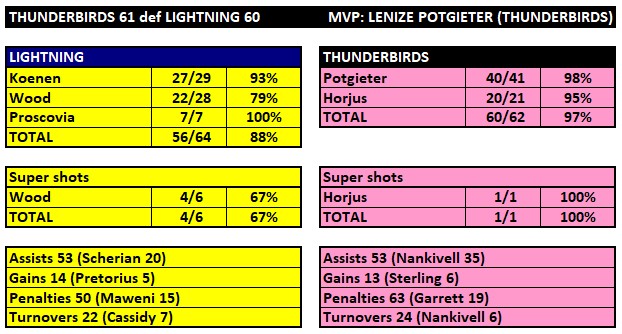
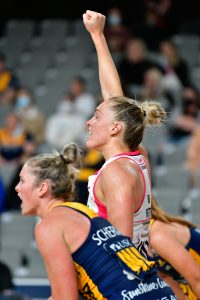
The game hung in the balance for the best part of 60 minutes. Image Simon Leonard

While athletes aren’t allowed to touch the net, what incredible elevation by Shamera Sterling. Image Simon Leonard
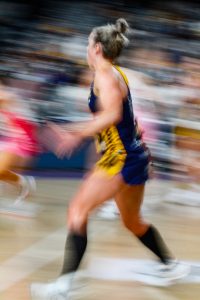
It’s hard to slow Laura Scherian down! Image Simon Leonard
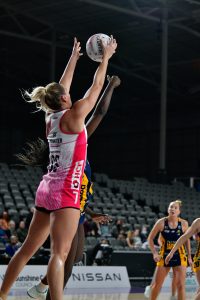
Lenize Potgeiter in her MVP performance. Image Simon Leonard
WHAT’S NEXT
It’s a quick turnaround for the first match of Round 13:
Thurs 29 July Firebirds v Magpies 6.00pm Nissan Arena
Mon 2 August Thunderbirds v Vixens 7.30pm Nissan Arena
Tues 3 August Lightning v Giants 3.30pm Nissan Arena
Tues 3 August Fever v Magpies 6.30pm Nissan Arena
Swifts have a bye round and will play two matches in Round 14
PODCASTS
This year, Netball Scoop has teamed up with The Netball Show Podcast and The Netty Life Podcast to bring you all of our Suncorp Super Netball post-match interviews. Hear from your favourite players and coaches as they dissect the matches and get candid about ways they can improve throughout the season.
Listen now on your favourite podcast aps.
